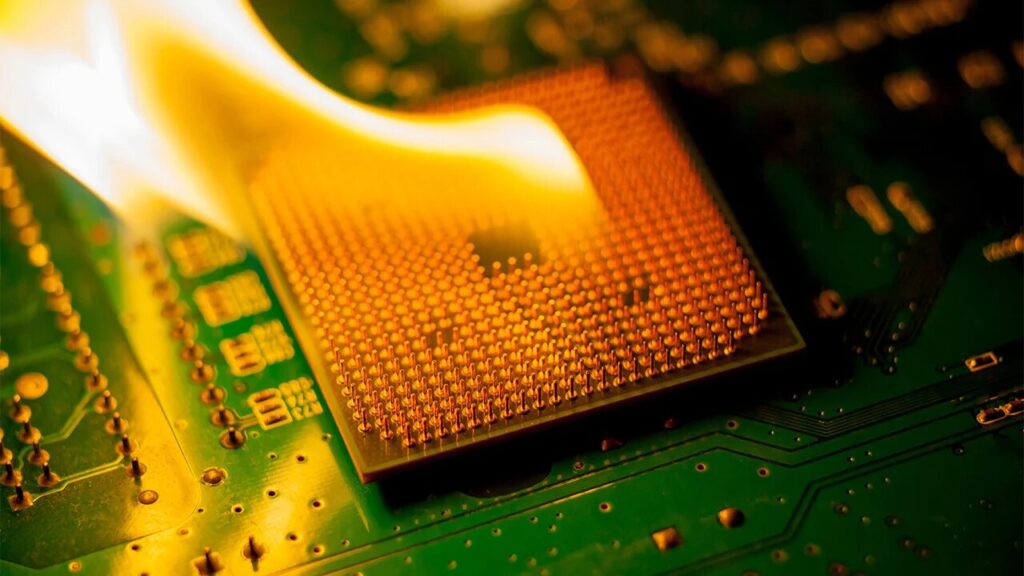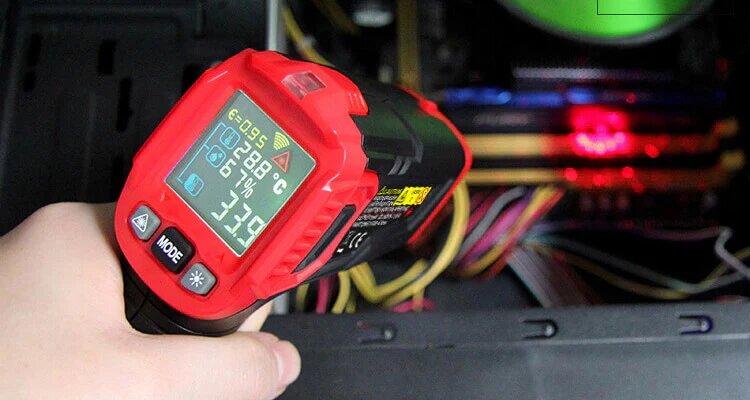Your CPU is the brain of your computer, but just like any brain, it can get overheated if pushed too hard. Monitoring CPU temperature is crucial because excessive heat can cause performance issues, system crashes, and even permanent damage. But what’s too hot for a CPU?
A CPU is too hot when it exceeds 85-90°C under load. Ideal temperatures are 40-65°C when idle and 70-85°C under heavy use. Overheating can cause throttling, crashes, or damage. Ensure proper cooling, clean dust, and apply thermal paste to prevent high temperatures.
Understanding the safe temperature range for your processor can help you prevent overheating and extend the lifespan of your computer.
Understanding CPU Temperatures!
1. How Do CPUs Generate Heat?
CPUs process billions of instructions per second, generating heat as a byproduct of electrical resistance. The harder your CPU works, the more heat it produces. High-performance gaming, video rendering, and heavy multitasking can all push your CPU to its thermal limits.
2. Ideal CPU Temperature Ranges:
- Idle Temperature: 30°C – 50°C (86°F – 122°F)
- Normal Load Temperature: 50°C – 70°C (122°F – 158°F)
- Heavy Load/Gaming Temperature: 70°C – 85°C (158°F – 185°F)
- Critical Temperature: 90°C+ (194°F+) – Risk of overheating and damage
What’s Too Hot for a CPU?
If your CPU often gets hotter than 85°C (185°F), it means it is running too hot. Most modern processors come with built-in safety features that help protect them from extreme heat. If the temperature gets too high, usually around 100°C or more, the computer will shut down automatically to prevent damage. However, even if your CPU does not reach these extreme levels, running at high temperatures for a long time is not good. It can cause parts inside your computer to wear out faster, which may lead to performance issues or even permanent damage over time.

Keeping your CPU cool is important to make sure your computer runs well and lasts longer. If your processor is often running at high temperatures, you may need to check for dust buildup, improve airflow inside your computer, or replace old thermal paste. Using a good cooling system, such as better fans or liquid cooling, can also help keep the temperature low. Regularly monitoring your CPU temperature can help prevent overheating and ensure your computer stays in good condition for years to come.
Common Causes of CPU Overheating!
- Poor ventilation – Blocked airflow restricts cooling.
- Dust accumulation – Clogs fans and heatsinks.
- Faulty cooling solutions – Inefficient fans or thermal paste issues.
- Overclocking – Increases power consumption and heat.
Optimal and Dangerous CPU Temperatures!
The table below provides a clear comparison of safe and dangerous CPU temperature ranges under different conditions:
| State | Safe Temperature (°C) | Warning Temperature (°C) | Dangerous Temperature (°C) |
| Idle | 30 – 50 | 50 – 60 | 60+ |
| Normal Use | 40 – 65 | 65 – 75 | 75+ |
| Gaming/Heavy Load | 70 – 85 | 85 – 90 | 90+ |
| Overclocking | 75 – 90 | 90 – 95 | 95+ (Critical) |
If your CPU reaches dangerous levels, improve cooling, check thermal paste, and ensure proper ventilation.
How to Monitor CPU Temperature?
If you want to check your CPU temperature, you can use different software tools that make it easy to monitor. Core Temp, MSI Afterburner, and HWMonitor are a few well-liked choices. These applications display temperature data in real time along with other crucial computer performance information.
You just need to download and install one of these tools, and it will give you an instant look at your CPU temperature. This helps you keep track of heat levels and make sure your computer is running smoothly. Many people use these tools to avoid overheating, which can slow down performance or even cause damage to the system.
Another way to check your CPU temperature is through the BIOS or UEFI, which you can access when you start your computer. Before the operating system loads, you can enter the BIOS or UEFI by pressing a specific key, usually F2, F10, Delete, or Esc, depending on your computer’s manufacturer.
What Happens If Your CPU Gets Too Hot?
- Thermal throttling – CPU reduces speed to cool down.
- System crashes – Overheating leads to shutdowns.
- Hardware damage – Prolonged heat exposure can degrade components.
How to Prevent CPU Overheating?
1. Improve Airflow with Good Case Fans:
Use high-quality case fans to keep air moving inside your computer. Better airflow helps to cool your system and prevent overheating.
2. Clean Your PC Regularly:
Remove dust from your computer and replace old thermal paste to keep it running smoothly. A clean PC stays cooler and works better.
3. Upgrade Your Cooling System:
If your computer gets too hot, consider upgrading to a better air or liquid cooling system. This helps maintain lower temperatures and improves performance.
Air Cooling vs. Liquid Cooling!
- Air cooling: Budget-friendly, easy maintenance.
- Liquid cooling: Superior cooling, quieter operation, higher cost.
Does Overclocking Affect CPU Temperature?
Yes, overclocking does increase the heat generated by the CPU, which can lead to potential damage if not managed properly. When you push the processor beyond its default speed, it requires more power, causing it to produce additional heat. To prevent overheating and ensure stable performance, it is essential to use high-performance cooling solutions such as advanced air coolers, liquid cooling systems, or thermal paste application to improve heat dissipation. Additionally, regularly monitoring CPU temperatures with reliable software can help detect any excessive heat buildup, allowing you to make necessary adjustments and avoid long-term hardware issues.
Best CPUs for Heat Management!
1. Low TDP CPUs – Save Power and Stay Cool:
Low TDP CPUs use less power and produce less heat, making them energy-efficient and cooler to run.
2. Advanced Cooling – Better Heat Control:
Modern cooling systems have built-in vapor chambers that help spread heat evenly and keep the device from overheating.
Myths About CPU Overheating!
- Myth: More fans always mean better cooling.
- Reality: Proper airflow is more important than quantity.
How Ambient Temperature Affects CPU Heat?
When the temperature in a room is too high, it can make a computer’s CPU hotter than normal. The CPU is like the brain of the computer, and it needs to stay at a safe temperature to work properly. If the room is too warm, the computer’s cooling system has to work harder to keep the CPU from overheating. This can make the computer slow down, crash, or even get damaged over time. Heat can also make the fans inside the computer run faster and louder, which can be annoying. If the CPU gets too hot for too long, it might stop working properly, and the computer could shut down to protect itself from damage. That’s why it’s important to make sure the computer stays in a place where it won’t get too hot.

To prevent overheating, it is best to keep the computer in a cool and well-ventilated area. A room with fresh air and good airflow helps the computer stay at a normal temperature. It’s a good idea to place the computer on a desk or a hard surface instead of a soft surface like a bed or a couch, as soft surfaces can block the airflow and trap heat. Keeping the area around the computer clean and free of dust can also help because dust can build up inside and make it harder for the fans to cool down the CPU. If possible, using an external fan or air conditioner in the room can also help keep the temperature lower. By taking these simple steps, the computer can stay cool, work better, and last longer without overheating problems.
What’s the Maximum Safe Temperature for Popular CPUs?
1. Maximum Safe Temperature for Intel CPUs:
Intel processors can safely handle temperatures up to 100°C before they get too hot.
2. Maximum Safe Temperature for AMD CPUs:
AMD processors can safely handle temperatures up to 95°C before they get too hot.
Future Technologies in CPU Cooling!
- AI-powered cooling solutions
- Advanced liquid metal thermal compounds
FAQs:
1. What is the safest CPU temperature range?
30°C – 70°C is ideal under normal use.
2. Can high CPU temperature damage my PC?
Yes, prolonged overheating can cause hardware failure.
3. What’s the best cooling method for gaming PCs?
Liquid cooling is superior for heavy gaming and overclocking.
4. Does thermal paste improve CPU cooling?
Yes, it enhances heat transfer from CPU to heatsink.
5. How often should I clean my PC for better cooling?
Every 3-6 months to prevent dust buildup.
Conclusion:
Maintaining the cooling of your CPU is crucial for both longevity and performance. By monitoring temperatures, using proper cooling, and preventing dust buildup, you can avoid overheating issues and ensure smooth operation.
Also Read:
- Best CPU Mount for Fractal Design North Case – A Comprehensive Guide!
- Intel i9 CPU Overheating on Gamers Nexus – Motherboard Compatibility and Cooling Challenges!
- New CPU Installed fTPM/PSP NV Corrupted – All Guide!
- Ntel I9 Cpu Overheating Motherboard Setting – Everything You Need To Know!
- The Ultimate Guide to Choosing the Best CPU Fan for 7800X3D










